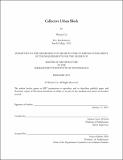Collective urban block
Author(s)
Cai, Wenxin,M. Arch.Massachusetts Institute of Technology.
Download1102595037-MIT.pdf (47.25Mb)
Other Contributors
Massachusetts Institute of Technology. Department of Architecture.
Advisor
Andrew Scott.
Terms of use
Metadata
Show full item recordAbstract
Since the economic reform in 1978, urban planning in China has shifted from spatial manifestation of economic planning to projective planning. This rapid mode of policy-driven urbanization has instrumentalized infrastructural development using the master plan as tools to promote urbanization for economic growth. The transformation of Beijing has epitomized how the master plan has replaced urban block as a spatial tool for the making of the city. The result of this practice is Le Corbusier's radiant city in a dystopian state: parallel blocks of residential towers enclosed in gated communities that are detached from the city. Currently, Beijing has a migrant population of 8 million, who called themselves "Bei Piao", literally translated as "floating in Beijing". The exclusive policy to cap population and exorbitant housing price further exclude migrants to live in the city. As Beijing continued to expand with the construction of new infrastructure, I will argue that development of infrastructure will not solve the problems of the city and make it more inclusive. Through the reading of the historical context of Beijing, the idea of collectivity is manifested, seen through historical urban forms of courtyard house and Hutong (alley). This thesis uses the vocabulary of historical neighborhood of Beijing, and investigates how collectivity can be formed through relational aspects of elements of architecture, such as courtyard, alley, window, balcony and terrace. This project intends to use key elements of architecture from the contextual reading to make a neighborhood of collective living in central Beijing. Rather than proposing a solution to reverse socio-spatial exclusiveness, the project intends to set up a framework, and imagine how it can be appropriated by future residents.
Description
This electronic version was submitted by the student author. The certified thesis is available in the Institute Archives and Special Collections. Thesis: M. Arch., Massachusetts Institute of Technology, Department of Architecture, 2019 "February 2019." Cataloged from student-submitted PDF version of thesis. Includes bibliographical references (page 92).
Date issued
2019Department
Massachusetts Institute of Technology. Department of ArchitecturePublisher
Massachusetts Institute of Technology
Keywords
Architecture.